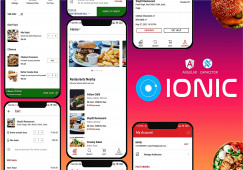-
Ionic is one of the most exciting and evolving technologies you should learn at the moment. It empowers you to build leading cross platform mobile apps (native mobile apps) for iOS and Android, and also Progressive Web Apps (PWAs) using one codebase (written in HTML, JS and CSS)
-
This course will introduce you to Ionic step by step and gradually adding more and more Ionic components. It teaches you the latest version of Ionic from scratch with no prior knowledge needed about it.
-
Angular allows you to create awesome web applications powered by TypeScript / JavaScript. We will use it to build web applications that can be compiled into native mobile apps, running on any iOS or Android device, also teach you to build progressive web apps with same codebase simultaneously.
-
The Ionic framework allows you to build Native Mobile Apps using your existing Angular, HTML, JS and CSS knowledge. Ionic provides a lot of beautiful components (which you will learn about in this course) that can be used to create Native like User Interfaces (UI).
Capacitor (a tool provided by the Ionic team) will be used to then build a native mobile app for iOS/ Android based on your code. This allows you to publish your application on all possible devices (desktop and mobile) without having to learn lots of different languages! So with Ionic, you can use one codebase to create 3 different apps (iOS, Android, web).
-
No wonder that hybrid frameworks like Ionic are extremely popular and getting into high demand day by day!
-
My name is Nikhil Agarwal and I am a professional web and app developer. I love creating awesome applications that are challenging and amazing.
-
This course takes you from being a newbie(zero) to expert (advanced level) in making Apps, taking a very practice orientated route. At first you will gain all the basics knowledge along with that you will build an app to use main Capacitor plugins and some basics concepts about Ionic. In the basics of Ionic you will learn about its rich component library, how to fetch and handle user input, how to store data and access native device features and much more! After bagging all the basics, you will build a realistic app (similar to Swiggy / Zomato / Uber Eats) in this course.
You will dive into all important Ionic components and concepts such as navigation, user input, native device features (e.g. camera, geolocation, call, contacts, local notifications, share etc.), storage, http, authentication!
-
And since building apps is only part of the fun, you will of course also learn how to run your apps either in the browser, on an emulator or on your own device!
-
Here is a quick rundown of what you are going to learn in this course?
– How to set up environment for Ionic projects in Windows & MAC
– How to run native apps in Emulator, Simulator & real devices for both iOS and Android. Also, testing app in browser, with all debugging tools
– The basics about Ionic: How navigation works, how your project is structured and you use its rich component library
– How to use the many beautiful components Ionic provides
– How to use modals, alerts, toasts and many, many more useful UI components
– How to fetch and handle user input through inputs, text fields, dropdowns, dialogs etc.
– How to authenticate users and access web servers to store and load data
– How to work with different Capacitor plugins for PWAs and Native Mobile Apps (using Capacitor v2 and Capacitor v3 also)
– Clean Coding Practice along with App Styling and theming
– And many more
-
Finally, you will learn how to configure your app and publish it to the App Store or Google Play Store (or as a progressive web app).
Does this sound great?
I cannot wait to welcome you in this course! 






There are no reviews yet.